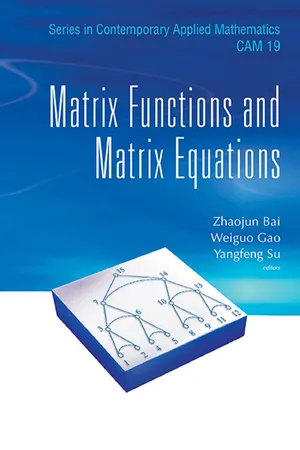
Matrix Functions And Matrix Equations
- 148 pages
- English
- ePUB (mobile friendly)
- Available on iOS & Android
Matrix Functions And Matrix Equations
About This Book
Matrix functions and matrix equations are widely used in science, engineering and social sciences due to the succinct and insightful way in which they allow problems to be formulated and solutions to be expressed. This book covers materials relevant to advanced undergraduate and graduate courses in numerical linear algebra and scientific computing. It is also well-suited for self-study. The broad content makes it convenient as a general reference to the subjects.Matrix functions and matrix equations are widely used in science, engineering and social sciences due to the succinct and insightful way in which they allow problems to be formulated and solutions to be expressed. This book covers materials relevant to advanced undergraduate and graduate courses in numerical linear algebra and scientific computing. It is also well-suited for self-study. The broad content makes it convenient as a general reference to the subjects.Readership: Researchers and graduate students in numerical and computational mathematics.Key Features:The book covers underlying theory and a variety of algorithms for matrix functions and matrix equations. The book also covers high performance linear system solvers and eigenvalue computations which are computational kernels to matrix functions and matrix equationsThe book provides the current developments and applications beyond the material found in regular university courses and textbooks. It includes a comprehensive list of latest referencesThe authors of the chapters are leading experts who are also well-known for their expository skills
Frequently asked questions
Information
Methods for Eigenvalue Problems


Table of contents
- Cover
- Halftitle
- Series Editors
- Title
- Copyright
- Preface
- Contents
- Matrix Functions: A Short Course
- A Short Course on Exponential Integrators
- Matrix Equations and Model Reduction
- Rayleigh Quotient Based Optimization Methods for Eigenvalue Problems
- Factorization-Based Sparse Solvers and Preconditioners